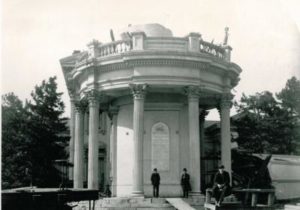It killed scores of people in downtown Louisville and tore up nearly everything in its path. Then it headed north up the river, and, as a parting shot, knocked down the Louisville Water Tower, snapping off the wooden shaft.
 The tornado of March 27, 1890 left “only short stumps” of the tower and its standpipe “to mock their former height and beauty,” Charles Hermany, Louisville Water Chief Engineer, wrote in his annual report
The tornado of March 27, 1890 left “only short stumps” of the tower and its standpipe “to mock their former height and beauty,” Charles Hermany, Louisville Water Chief Engineer, wrote in his annual report
There were two Cornish pumps inside Pumping Station No. 1. When their 58,000-pound plungers dropped, the standpipe had evened out pressure surges.
This allowed a smooth flow of water to the Crescent Hill Reservoir. No standpipe meant no pumping. The prospect of running out of a water was very real.
When the pumps were silenced, the Crescent Hill Reservoir was partially filled with 65 million gallons of water—enough to last just six days. To prevent a water famine, customers were asked to conserve, and water was cut off to elevators, distilleries, breweries, other manufacturers, and street sprinkling hydrants. These drastic measures helped. Five days later, on April 1, the reservoir still held 27 million gallons of water, but this was estimated to last three and a half days, so Louisville Water needed the pumping station back online—and soon.
Hermany did a bit of problem solving, and this is where Louisville Water caught a little luck with the timing of the disaster. Hermany temporarily reconfigured the standpipe. Employees capped it to create an air vessel that used compressed air to provide back pressure for the pumps. The lucky part was that air compressors were already located on the site because Pumping Station No. 2 was under construction. Hermany was pleasantly surprised at how well his idea worked.
For a more permanent solution, the standpipe needed to be rebuilt, meaning the Cornish pumps needed to be shut down again. Louisville Water bought two 3 MGD duplex pumps. They did not need the standpipe to work, but they did need boilers to provide steam. Another bit of luck: Finding temporary boilers was no problem because the ones used to power the air compressors from the construction site were available.
The loss of the air compressors and their boilers did not hamper work on the pumping station because progress had already been slowed by delays in getting stone delivered.
Less than a month before the tornado, Hermany had presented a chilling report to Louisville Water’s board of directors: the cast iron beams supporting the easterly pump had sunk from 2 1/2 to 3 1/2 inches. The pump was loose and getting looser.
For the previous decade, workers had made temporary repairs by hammering in iron wedges to stabilize it, but now the pump was getting so loose it could not be operated safely. A permanent repair would require the pump to be taken offline, but because there wasn’t any extra pumping capacity before the tornado, the repair was impossible.
When the pumps were taken offline for the rebuilding of the standpipe, workers could make better repairs. They hammered a total of 61 wedges into place to stabilize the pump. Still, it was not a permanent fix. That would have to wait for the completion of Pumping Station No. 2.

